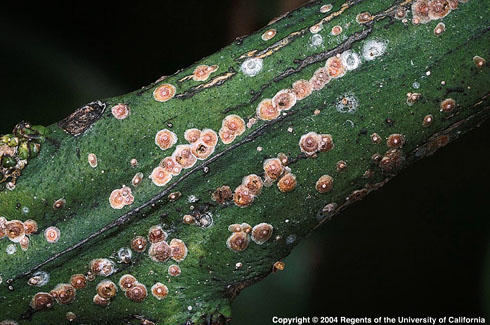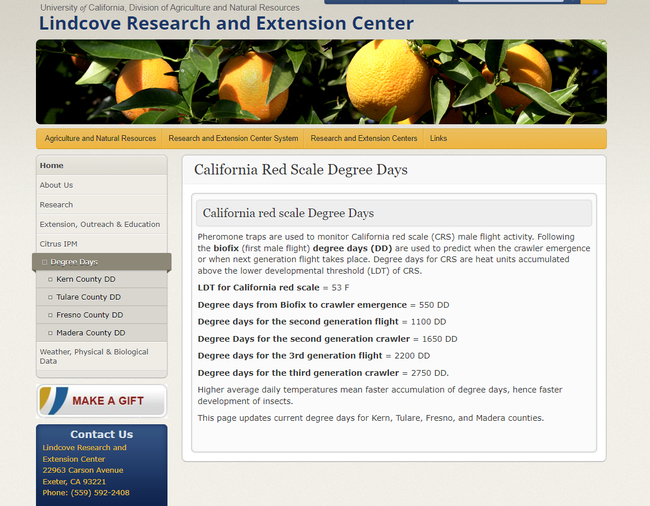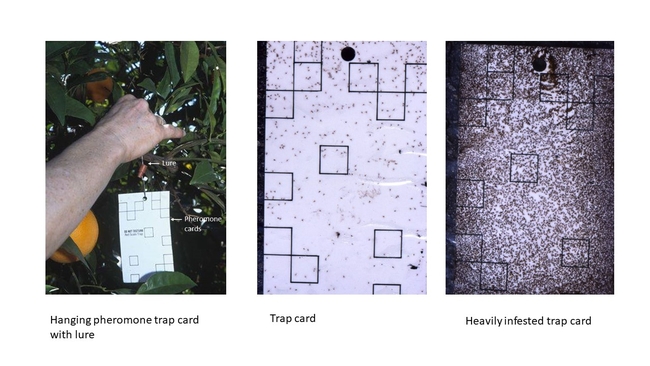- Author: Sandipa Gautam
Monitoring California red scale populations by using pheromone traps and degree days
California red scale is an armored scale that attacks all citrus varieties. It attacks all aerial parts of the tree including leaves, fruits, twigs, and branches by sucking on plant tissue with its long filamentous stylet. Heavy infestations cause leaf yellowing and drop, dieback of twigs, and occasional death of the infested tree. Heavily infested fruits with patches of California red scale may be downgraded in the packinghouse. Growers use monitoring methods, i.e., pheromone trapping, examining fruit, and bin counts (at harvest) for making treatment decisions.
In the San Joaquin Valley, many citrus growers rely on the use of pheromone traps to monitor male-scale flights. Following the biofix (first male flight) degree day units (DD) are used to predict when the next crawler emergence or next-generation flights is occurring. Degree days are heat units accumulated above the lower developmental threshold of an insect and have been long used to monitor the seasonal activity of California red scale populations. Knowing when the most vulnerable life stage of the insect is present helps growers make timed insecticide applications.
Citrus IPM research group led by Dr. Sandipa Gautam at Lindcove Research and Extension Center updates degree day accumulation in the San Joaquin Valley counties. Information for different counties can be found here.
Pheromone traps are used to monitor either weekly changes in male flights or to track densities during flights, especially the fourth flight.
The squares represent 20% of the card – you count what is inside the squares on both sides and multiply by 5 to estimate the total number.
How to use pheromone traps for weekly monitoring male flights?
- Monitor 5 to 6 orchards that have a known population of California red scales every week,so thatyou can determine when flights are occurring and time sprays.
- Change the sticky cards weekly and the pheromone lure caps monthly through October.
- Use two to four pheromone traps per10-acre block;add two traps for each additional10 acres.
How to use trap card information to make management decisions?
- Hang pheromone traps with a fresh lure in early March to detect the biofix (first male flight). Historically, biofix for Kern County occurs around the 1st of March, and biofix for Tulare, Fresno, and Madera Counties occurs around March 15.
- Use the biofix and degree-days to predict when crawler emergence or next flight is occurring. Degree days are accumulated heat units over the lower developmental threshold of California red scale.
- Crawler emergence for first-generation will occur 550 degrees days after biofix.
- Subsequent flights will occur at intervals of 1,100-degree days after the biofix of the first male flight (1,100 DD for 2nd flight; 2,200 DD for 3rd flight; 3,300 DD for 4th flight and 4,400 DD for 5th flight). Subsequent crawler emergence for the 1st, 2nd, and 3rd generation occurs at 550 DD, 1650 DD, and 2750 DD after the biofix.
- Check the Lindcove Research and Extension Center Website for updated information on accumulated degree day
How to use pheromone traps to determine areas of heavy infestation?
- Use 2 to 4 pheromone traps per10-acre block;add 2 traps for each additional10 acres.
- Time placement of traps at the beginning of the biofix for the flight and remove them at the end of each flight and count scales and record the numbers.
In the past, when an average of more than 1,000 scales are trapped during the 4th flight and fruit is infested with scale at harvest, a pesticide application is planned for the next season. However, this threshold of 1,000 scales per flight developed in the 1980s is no longer a stand-alone tool for determining when treatments are necessary. It is critical to use other tactics, such as fruit and twig examination.
Note that pheromone cards are not reliable predictors of scale populations on their own. In all orchards in all growing regions,whether Aphytis wasps are released or not, conduct visual inspections of citrus fruit once a month during August, September, and October to confirm that fruit is free of scale.
Situation 1: Scale densities on traps may be high, but the fruit is free of scale:
- When Movento or Admire (and generics) are used because they remove scale from leaves and fruit but not the wood of the tree.
- Aphytis prefer to attack virgin female scales and the males may escape parasitization, resulting in a high number of male scales on traps.
Situation 2: Very few male scales on traps, but the scale is found on fruit
- When insect growth regulators (buprofezin and pyriproxyfen) are used, the frequently molting male scales are more affected than female scales.
- When mating disruption is used, males cannot find the trap cards so their densities on traps can be very low. A threshold of 50 scales per flight is helpful in determining if mating disruption is effective.
Consult UCIPM guidelines for management options.





